Main Menu
Latest Blog Entry
User login
Swimming dryland training: Nick Folker seminar
“Work on athleticism not swimmingism”
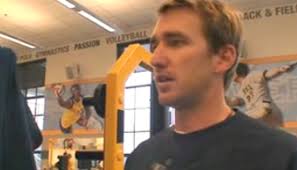
Nick Folker
Nick Folker presenting at GAIN in June this year. I learnt more in this seminar about so called “dryland” training than I have done speaking to swim coaches over the last 10 years.
My impression of “dryland” training as commonly conducted is that it’s an Omnishambles.
A random series of therabands, medicine balls and “core” exercises that are thrown together base upon which youtube video the coach had watched the night before or copied from “what I did when I was swimming”.
When I would ask why they did this or that exercise, or what the progressions were I would get “It’s dryland training, so it’s up to us swimming coaches to design it”.
Watching Nick speak was a breath of fresh air: he is an Olympian, but more importantly he has looked carefully at what is needed to make swimmers faster. He has avoided the need to follow the herd.
Posture is key
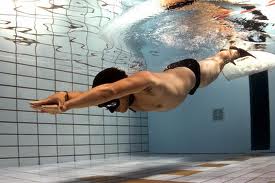 Posture is as important in swimming, as it is in every sport. Keeping a streamlined position means there is less drag in the water.
Posture is as important in swimming, as it is in every sport. Keeping a streamlined position means there is less drag in the water.
Technique is important, with a common fault being over rotation which then forces the swimmer to have to rotate back the other way, creating more turbulence.
Land training must help improve the posture and control of the body which then aids the swimming technique.
(This is the same as in other sports such as cricket, where physical development leads into technical development. It is difficult to conduct fielding practice if you are unable to lunge low and deep).
“Swimming chooses the athlete”
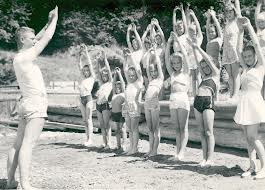 Nick spent some time talking about the current state of swimmers physical development when he first meets them.
Nick spent some time talking about the current state of swimmers physical development when he first meets them.
Poor posture, poor lifestyle, over specialised, and a low overall athletic ability. This has to be accounted for when beginning coaching.
(In the picture above you can see the coach demonstrating incorrectly the streamline position. Some of the kids are doing it correctly, others are hinging at the lower back to get hands above their heads!)
Power and force production for swimmers
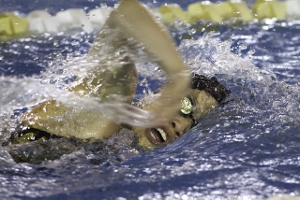 When trying to Run Faster, we want the maximum amount of force produced in the minimal amount of ground contact time: we want to “run in the air”.
When trying to Run Faster, we want the maximum amount of force produced in the minimal amount of ground contact time: we want to “run in the air”.
Swimmers need the opposite: a long contact time to produce force, and a minimal amount of time recovering the stroke.
Nick called this his “Aha” moment after seeing Gary Winckler present (benefit of GAIN as a community of practice: learning from other sports).
This has implications for strength training: most swimmers break down because they are unable to maintain force production. It is a power endurance issue.
The choice of exercise is also important: too much rotation causes problems. The rotation needs to be minimal but linking between upper body and hips for the long axis strokes (freestyle & back stroke). The hip hinge is more important for the short axis strokes (breaststroke & butterfly).
Nick uses exercises that have the feet off the floor and have the hands and feet as far away as possible to practice this linking. These are placed towards the end of the session, after the heavier lifting has taken place.
It was this type of detail that was very useful to me, having no swim background. I am uncertain as to whether many swim coaches look at this connection.
Take home messages
Nick had some take home points about specific things to avoid:
- Hypertrophy training: no place for swimmers as a goal in itself.
- Slow movements for pros: % of improvement is miniscule for professionals. Has its place in developing athletes.
- General circuit training: why burn the candle at both ends?
- Running: why do “cardio” when they do that enough in the pool?
- Barbell snatch: causes shoulder stiffness because hands are in wrong position for swimming.
He had some things that he likes to include:
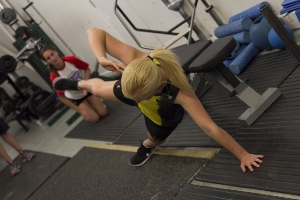 Pliometrics in 99% of the workouts: even if it is only 1-2 jumps
Pliometrics in 99% of the workouts: even if it is only 1-2 jumps- Train in the gym first, then the pool: this links to adaptation/ application.
- Weighted pull ups: rather than max pull ups, it is how much load they can lift for 2-3 reps (50+kg for the sprinters). Wide grip for breast stroke and butterfly, narrow for freestyle/ backstroke.
- Single leg work: helps the swimmers on the blocks. Tall athletes find it hard to get down to start: they wobble before they dive!
- Scapular stability: the cornerstone of the upper body workout. This is different from single joint theraband exercises that allegedly work the rotator cuff.
Summary
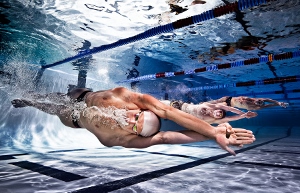 I had the opportunity to chat quite a lot with Nick at GAIN, I had some specific questions to ask to help the Modern Pentathletes I coach. He helped explain the start position and dive which we have since implemented.
I had the opportunity to chat quite a lot with Nick at GAIN, I had some specific questions to ask to help the Modern Pentathletes I coach. He helped explain the start position and dive which we have since implemented.
This seminar was an excellent example of taking an unfamiliar sport (for me) and applying sound training principles and designs that we could understand. I have taken this approach to working with swimmers previously (but without this level of detail) and some coaches like it.
However, faddism is prevalent in the swimming world, and it is a work in progress changing this. I was able to relate this on the recent Level 1 Strength and conditioning course which had two swimming coaches on it.
Honourable mentions to Chris Webb and Avery Adams who were also at GAIN and were very patient with my questions and open to sharing.
Client Testimonials
I feel that training with South West Talent and James Marshall has been the best thing I've done for my basketball career so far. It has greatly improved my overall athleticism which has been a real benefit to me when on court. More importantly, however, the training has enabled me to continue playing whilst suffering from a back injury which has caused me real problems over a number of years. It has made huge improvements more recently and I am confident that I will be in good shape to play this coming season.
More


Comments
[…] A guide to swimmimg dryland training A review of an excellent seminar by Nick Folker which has shaped our strength and conditioning […]